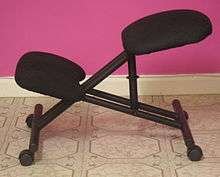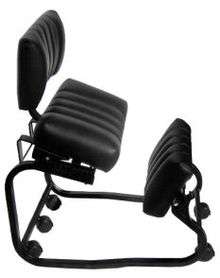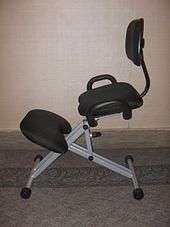Kneeling chair



A kneeling chair is a type of chair for sitting in a position with the thighs dropped to an angle of about 60º to 70º from vertical (as opposed to 90º when sitting in a normal chair), with some of the body's weight supported by the shins.
History
In 1979, Hans Christian Mengshoel invented the original kneeling chair of modern times, the Balans chair. Three Norwegian designers, Oddvin Rykken, Peter Opsvik, and Professor Svein Gusrud developed chairs based on the same principle.[1][2][3][4]
Purpose
The kneeling chair is meant to reduce lower back strain[5] by dividing the burden of one's weight between the knees and the buttocks. People with coccyx or tailbone pain resulting from significant numbers of hours in a sitting position (e.g., office desk jobs) are common candidates for such chairs. However, it is not proven that kneeling chairs are an optimal solution.
A proper kneeling chair creates the open body angle by lowering the angle of the lower body, keeping the spine in alignment and the sitter properly positioned to task.[6] The benefit of this position is that if one leans inward, the body angle remains 90º or wider. A misconception regarding kneeling chairs is that the body's weight bears on the knees, and thus users with poor knees cannot use the chair.[7] In a proper kneeling chair, most of the weight remains on the buttocks, and some of the weight bears on the shins, not the knees. The primary function of the shin rests (knee rests) is to keep one from falling forward out of the chair.
A saddle chair provides another way to keep the body from falling forward; this type of seat is generally seen in some sit stand stools, which seek to emulate the straddle riding or saddle position of a horseback rider.
Academic studies
Conclusions from scientific work on the possible benefits of the kneeling position point in different directions.
Ericson and Goldie studied "spinal shrinkage" in subjects using three different types of chairs while performing video display unit work and, in an eight-person study, found that subjects shrank more when sitting on a forward sloping chair with knee support than on a conventional chair.[8]
Dr. A. C. Mandal’s research from the 1960s and 1970s concluded that a forward sloping seat did effectively tip the pelvis forward, opening up the angle between torso and thigh, and thereby correctly aligns the spine, indicating a more suitable position for long periods of sitting.[9]
Drury and Francher studied the original Balans kneeling chair in 1985, concluding that overall it was "no better than conventional chairs and could be worse than well-designed conventional office chairs".[10]
Lander, et al. conducted another experiment in 1987 comparing the kneeling chair with a conventional chair, and concluded that their experimental data "do not support the manufacturer's claim that the Balans chair is likely to decrease complaints of [lower-back pain]".[11]
A 1989 study on a sample of 20 subjects concluded that the Balans chair promoted greater lumbar curvature than the "straight back chair" during relaxed sitting, typing, and writing, and that it could contribute to treatment of lower back injuries.[12]
A more recent study from 2008 confirms that "ergonomically designed kneeling chairs set at +20º inclination do maintain standing lumbar curvature to a greater extent than sitting on a standard computer chair".[13]
References
- ↑ "Balans: A Design Revolution". The Federation of Norwegian Industries. Archived from the original on 2013-03-21. Article about the original Balans chair.
- ↑ Diane Burley (n.d.). "Peter Opsvik". Pure Contemporary.com. Archived from the original on 24 July 2011. Retrieved 18 March 2011.
- ↑ "Kein Tod, kein Leben" [No Death, No Life] (in German). Der Spiegel. 3 June 1991. Retrieved 18 March 2011.
- ↑ Sigrid Rømcke Thue (n.d.). "Peter Opsvik". Store norske leksikon (in Norwegian). Institusjonen Fritt Ord. Retrieved 18 March 2011.
- ↑ Ergonomic Benefits of Kneeling Chairs | Yoor Wellness
- ↑ Hard Facts About Soft Machines: The Ergonomics Of Seating. Google Books. Retrieved 2012-10-17.
- ↑ Stephen Pheasant, Christine M. Haslegrave. Bodyspace: Anthropometry, Ergonomics and the Design of Work (Third ed.). Google Books. Retrieved 2012-10-17.
- ↑ Ericson, M.; Goldie, I. (1989). "Spinal shrinkage with three different types of chair whilst performing video display unit work". International Journal of Industrial Ergonomics. 3 (3): 177. doi:10.1016/0169-8141(89)90017-6.
- ↑ Dr. A. C. Mandal. "Study Report: Balanced Sitting Posture on Forward Sloping Seat".
- ↑ Drury, C. G.; Francher, M. (1985). "Evaluation of a forward-sloping chair". Applied Ergonomics. 16 (1): 41–47. PMID 15676532. doi:10.1016/0003-6870(85)90145-0.
- ↑ Lander, C.; Korbon, G. A.; Degood, D. E.; Rowlingson, J. C. (1987). "The Balans chair and its semi-kneeling position: an ergonomic comparison with the conventional sitting position". Spine. 12 (3): 269–272. PMID 2954222. doi:10.1097/00007632-198704000-00014.
- ↑ Bennett, D. L.; Gillis, D. K.; Portney, L. G.; Romanow, M.; Sanchez, A. S. (1989). "Comparison of integrated electromyographic activity and lumbar curvature during standing and during sitting in three chairs". Physical therapy. 69 (11): 902–913. PMID 2813518.
- ↑ Bettany-Saltikov, J.; Warren, J.; Jobson, M. (2008). "Ergonomically designed kneeling chairs are they worth it? : Comparison of sagittal lumbar curvature in two different seating postures". Studies in health technology and informatics. 140: 103–106. PMID 18810008.